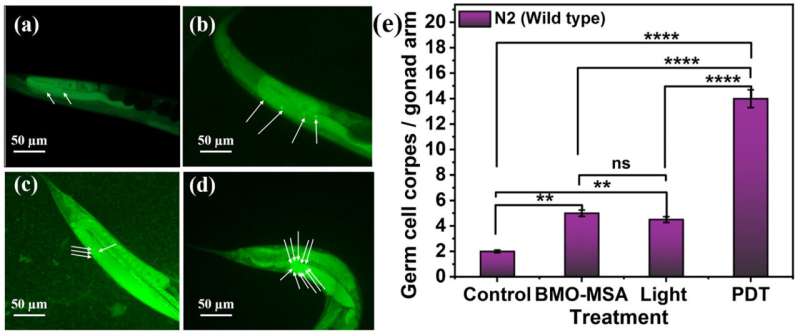Nanocomposite developed for NIR-II light-boosted photodynamic/chemodynamic therapy

Recently, a research team led by Prof. Huang Qing at the Institute of Intelligent Machines, Hefei Institutes of Physical Science (HFIPS) provided a new nanocomposite based on Bi2MoO6/MoS2/AuNRs for near-infrared (NIR)-II light-boosted photodynamic/chemodynamic therapy.
The results have been published in Langmuir.
Bi2MoO6 (BMO) nanoparticles (NPs) have been extensively used in photocatalytic applications and utilized as a photosensitizer in photodynamic therapy. However, their UV absorption property hinders their clinical application.
In this research, scientists designed a new nanocomposite named Bi2MoO6/MoS2/AuNRs (BMO-MSA). They found that the resulting nanocomposite can absorb light in the NIR-II range. The outcomes of the research revealed that after exposure to light with wavelength 1064 nm, the BMO-MSA produced singlet oxygen (1O2) with a quantum yield of 0.32, which confirmed its photodynamic therapy (PDT) ability. Moreover, it has POD-like activity, which enhances the chemodynamic therapy (CDT) effect.
To investigate the in vivo PDT efficiency of BMO-MSA, the researcher studied the germline apoptosis based on their previously C. elegans-established PDT model. The findings demonstrated that PDT caused germline apoptosis in the worm through the cep-1 pathway due to DNA damage. This finding was further supported by the utilization of a variety of mutants that had a lack of function related to DNA damaged genes.
This work has not only provided a novel PDT agent which may be used for PDT in the NIR-II region but also introduced a new approach to therapy taking advantage of both PDT and CDT effects, according to the team.
More information:
Qilin Yang et al, Deterioration Effects of Oxidative Aging on Graphene-Asphalt Nanocomposite Interfaces: Multiscale Modeling, Langmuir (2023). DOI: 10.1021/acs.langmuir.3c00917
Citation:
Nanocomposite developed for NIR-II light-boosted photodynamic/chemodynamic therapy (2023, June 7)
retrieved 7 June 2023
from https://phys.org/news/2023-06-nanocomposite-nir-ii-light-boosted-photodynamicchemodynamic-therapy.html
This document is subject to copyright. Apart from any fair dealing for the purpose of private study or research, no
part may be reproduced without the written permission. The content is provided for information purposes only.
For all the latest Science News Click Here
For the latest news and updates, follow us on Google News.

